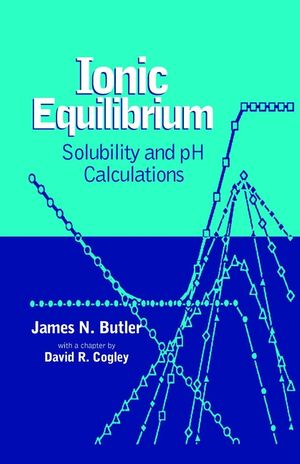Ionic Equilibrium: Solubility and pH CalculationsISBN: 978-0-471-58526-8
Hardcover
576 pages
April 1998
 This is a Print-on-Demand title. It will be printed specifically to fill your order. Please allow an additional 10-15 days delivery time. The book is not returnable.
|
||||||
A celebrated classic in the field updated and expanded to includethe latest computerized calculation techniques
In 1964, James N. Butler published a book in which he presentedsome simple graphical methods of performing acid-base, solubility,and complex formation equilibrium calculations. Today, both thebook and these methods have become standard for generations ofstudents and professionals in fields ranging from environmentalscience to analytical chemistry. Named a "Citation Classic" by theScience Citation Index in 1990, the book, Ionic Equilibrium,continues to be one of the most widely used texts on the subject.So why tamper with near-perfection by attempting a revision of thatclassic? The reason is simple-- the recent rapid development andwide availability of personal computers.
In the revised Ionic Equilibrium, Dr. Butler updates his 1964 workby abandoning the slide rule and graph paper for the PCspreadsheet. He also expands the original coverage with extensivematerial on basic principles and recent research.
The first part of Ionic Equilibrium is devoted to the fundamentalsof acid-base, solubility, and complex formation equilibria. In thesecond part, the author discusses oxidation-reduction equilibria,develops the principles of carbon dioxide equilibria, presents casestudies demonstrating the ways in which carbon dioxide equilibriaare used in physiology and oceanography, and explores thepossibility of a pH scale for brines. The concluding chapter,written by David R. Cogley, gives examples of general computerprograms that are capable of performing equilibrium calculations onsystems of many components.
Replete with real-world examples, details of importantcalculations, and practical problems, Ionic Equilibrium is an idealcourse text for students of environmental chemistry, engineering,or health; analytical chemistry; oceanography; geochemistry;biochemistry; physical chemistry; and clinical chemistry. It isalso a valuable working resource for professionals in those fieldsas well as industrial chemists involved with solution chemistry.
In 1964, James N. Butler published a book in which he presentedsome simple graphical methods of performing acid-base, solubility,and complex formation equilibrium calculations. Today, both thebook and these methods have become standard for generations ofstudents and professionals in fields ranging from environmentalscience to analytical chemistry. Named a "Citation Classic" by theScience Citation Index in 1990, the book, Ionic Equilibrium,continues to be one of the most widely used texts on the subject.So why tamper with near-perfection by attempting a revision of thatclassic? The reason is simple-- the recent rapid development andwide availability of personal computers.
In the revised Ionic Equilibrium, Dr. Butler updates his 1964 workby abandoning the slide rule and graph paper for the PCspreadsheet. He also expands the original coverage with extensivematerial on basic principles and recent research.
The first part of Ionic Equilibrium is devoted to the fundamentalsof acid-base, solubility, and complex formation equilibria. In thesecond part, the author discusses oxidation-reduction equilibria,develops the principles of carbon dioxide equilibria, presents casestudies demonstrating the ways in which carbon dioxide equilibriaare used in physiology and oceanography, and explores thepossibility of a pH scale for brines. The concluding chapter,written by David R. Cogley, gives examples of general computerprograms that are capable of performing equilibrium calculations onsystems of many components.
Replete with real-world examples, details of importantcalculations, and practical problems, Ionic Equilibrium is an idealcourse text for students of environmental chemistry, engineering,or health; analytical chemistry; oceanography; geochemistry;biochemistry; physical chemistry; and clinical chemistry. It isalso a valuable working resource for professionals in those fieldsas well as industrial chemists involved with solution chemistry.



